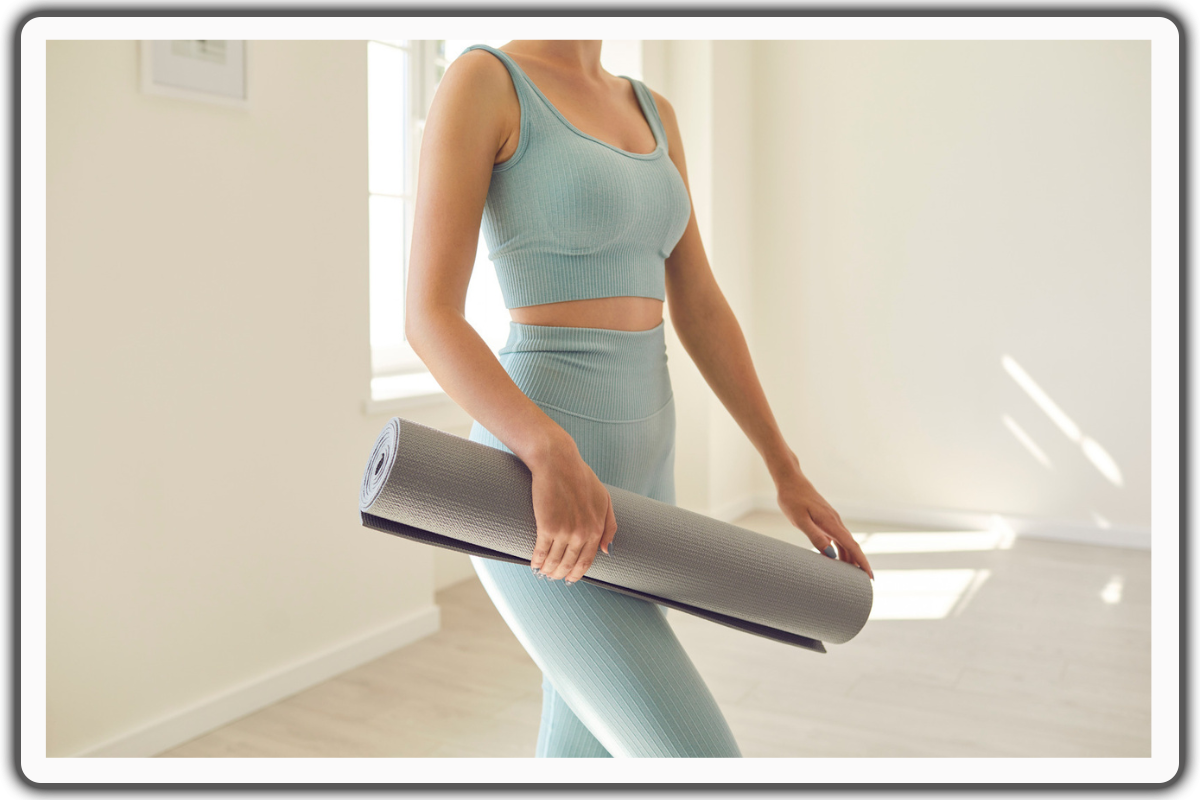
Strong and Sleek: The Best Pilates Leg Exercises For You
In pursuing a balanced and empowered physique, Pilates emerges as a beacon of strength and grace, offering a holistic approach to fitness that transcends mere physicality. At the heart of this transformative practice lies a deep focus on core stability, flexibility, and muscular endurance. However, amidst the myriad of Pilates exercises, the emphasis on leg strength often stands out as a cornerstone of a well-rounded routine .
As we delve into Pilates leg exercises, sculpted limbs, and enhanced vitality. This journey is not merely about physical aesthetics but about fostering a profound connection between mind, body, and spirit. In this comprehensive guide, we will explore the fundamental principles of Pilates, the significance of leg exercises within this framework, and unveil a curated selection of the best Pilates leg exercises tailored to elevate your practice and unlock your full potential.
Join us as we delve into the essence of Pilates, uncover the transformative power of leg-focused workouts, and embark on a path toward a stronger, sleeker, and more vibrant you.
Importance of Pilates Leg Exercises
Pilates leg exercises are integral to the method's comprehensive approach to fitness, targeting muscle groups like the quadriceps, hamstrings, glutes, and calves to enhance lower body strength and stability. By emphasizing core engagement, these exercises foster a stronger mind-body connection and promote better posture, reducing the risk of injuries related to poor mechanics.
Additionally, the best Pilates exercises emphasize the importance of flexibility and a wide range of motion, preventing injuries and rehabilitation by stretching muscles and promoting joint health. Their focus on functional movement patterns further improves overall functional fitness, benefiting daily activities and sports performance.
Incorporating Pilates leg exercises into one's routine can lead to a stronger, more balanced, and resilient body, enhancing overall health and well-being.
Pilates Principles
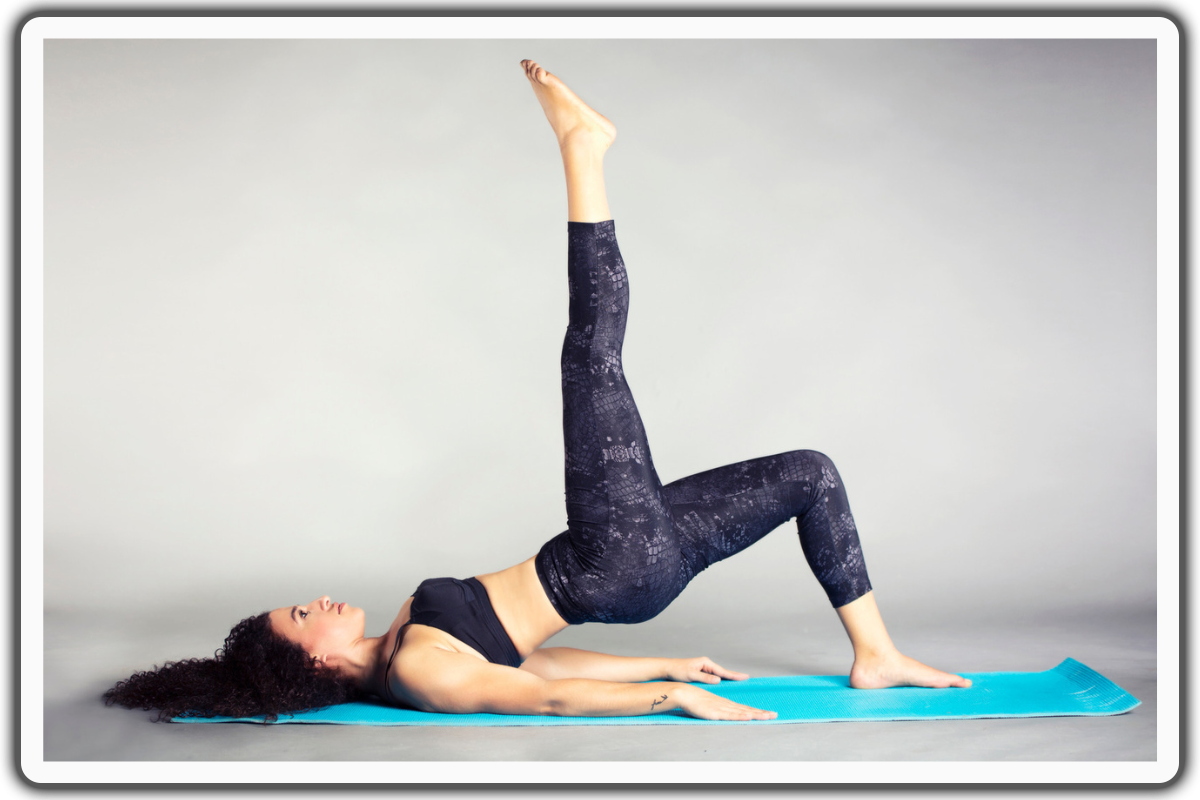
Flow
Pilates emphasizes smooth and continuous movements, maintaining a natural flow between exercises. It's about moving gracefully from one position to another, keeping the body in a constant, rhythmic motion. Flow encourages a seamless integration of breath and movement, promoting a sense of fluidity and relaxation throughout the practice.
Control
Pilates also focuses on control, which involves executing movements with precision and intention. Each exercise is performed deliberately, with a keen awareness of the muscles engaged. Pilates emphasizes control and helps develop strength, stability, and coordination while minimizing strain or injury.
Precision
Pilates prioritizes precision in movement, emphasizing the importance of proper alignment and technique. It's about performing each exercise with accuracy and attention to detail, targeting specific muscle groups effectively. Precision ensures that movements are executed correctly, maximizing their benefits and reducing the risk of strain or imbalance.
Centering
In Pilates, centering refers to initiating movement from the body's core or powerhouse. This involves engaging the deep muscles of the abdomen, pelvis, and lower back to stabilize the body and support movement. Focusing on centering, Pilates helps develop core strength, stability, and balance, which are essential for overall health and fitness.
Concentration
Concentration is key in Pilates, requiring focused attention and mindfulness. It's about being fully present in the moment, tuning out distractions, and connecting with the body's sensations. By cultivating concentration, Pilates promotes mental clarity, body awareness, and a deeper mind-body connection, enhancing the overall effectiveness of the workout.
Best Pilates Leg Exercises
From leg rotations to knee-to-shoulder lifts, these simple yet effective movements offer a path to sculpted limbs and enhanced vitality.
1. Standing Leg Rotations
Hold on to the back of a chair or couch for support and balance for this exercise.
Begin in an upright standing position, maintaining proper alignment with your head, shoulders, and hips. Place one hand on the back of the chair for support and balance. Engage your core and raise one knee up towards your chest, ideally to a 90-degree angle. Rotate your knee out to the side and back down to the center position to return to the starting position. Repeat the movement on the other leg. Start with 1 set with 10 repetitions on each leg.
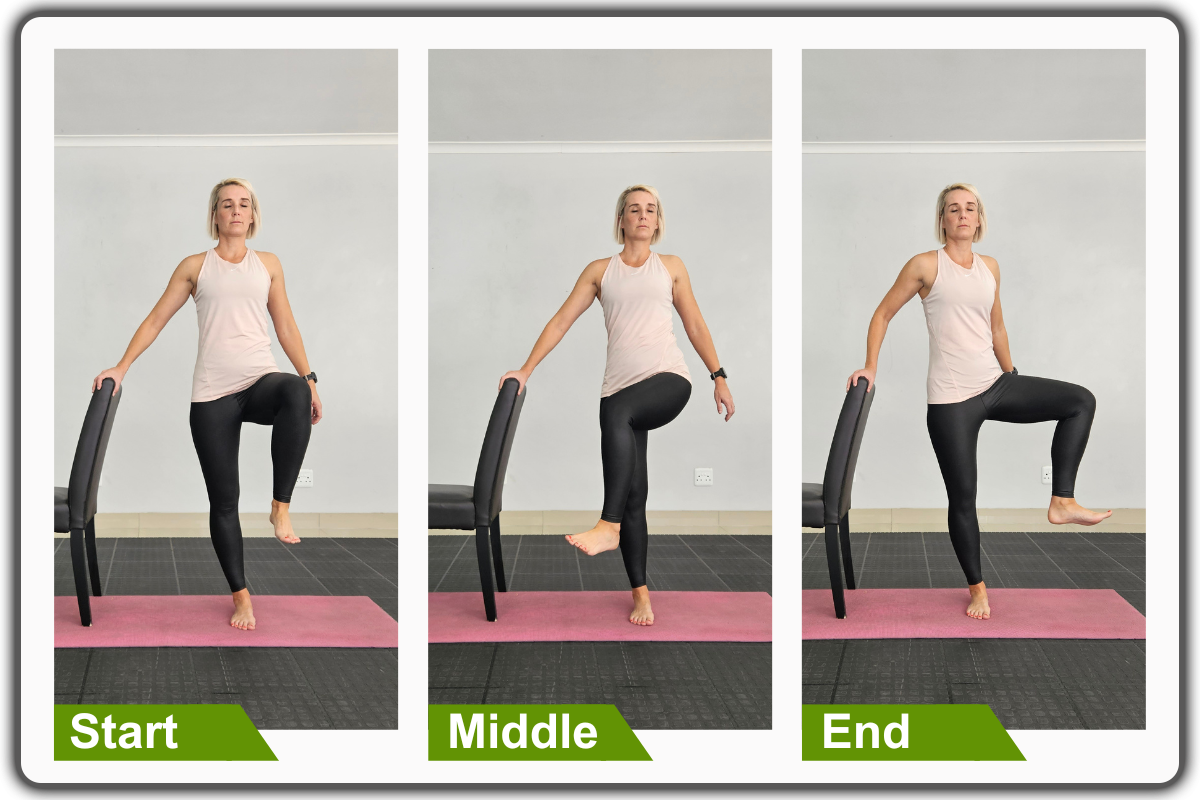
2. Knee to Shoulder
Begin in an upright sitting position on a chair with your feet hip-width apart, maintaining good alignment with your head, shoulders, and hips. Place your right hand on your shoulder and engage your core. Lift your left knee up towards your chest as you counter the movement by lowering your opposite elbow. Return to the starting position and repeat the movement. After several repetitions, perform the movement with your right knee. Begin with 3 sets of 10 repetitions on each side.
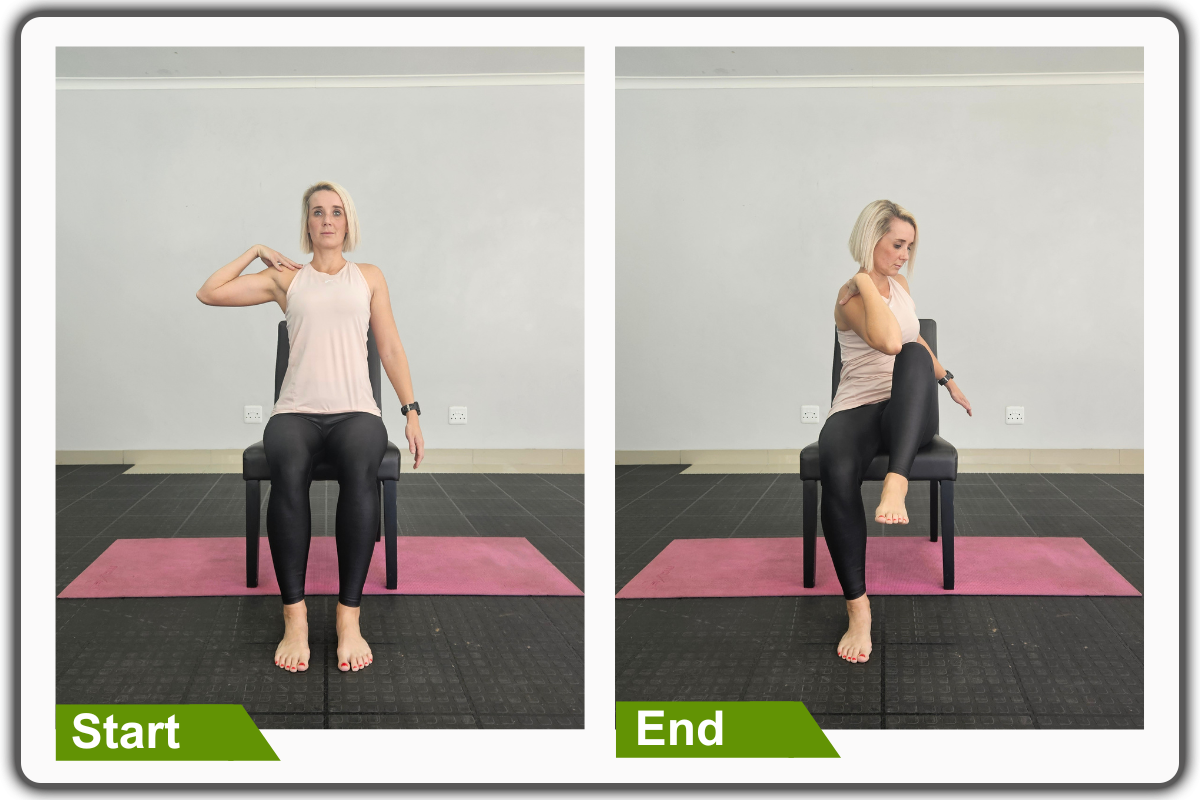
3. Bridging
Lie on your back on the floor with your knees bent and feet flat on the floor, maintaining good alignment with your head, shoulders, and hips. Place your arms at your sides. Engage your core and push from your heels to lift your hips, squeezing your glutes at the end position. Hold this position for several deep belly breaths in through your nose and out through your mouth. Slowly lower your hips to return to the starting position. Start with 1 set of 5 repetitions.
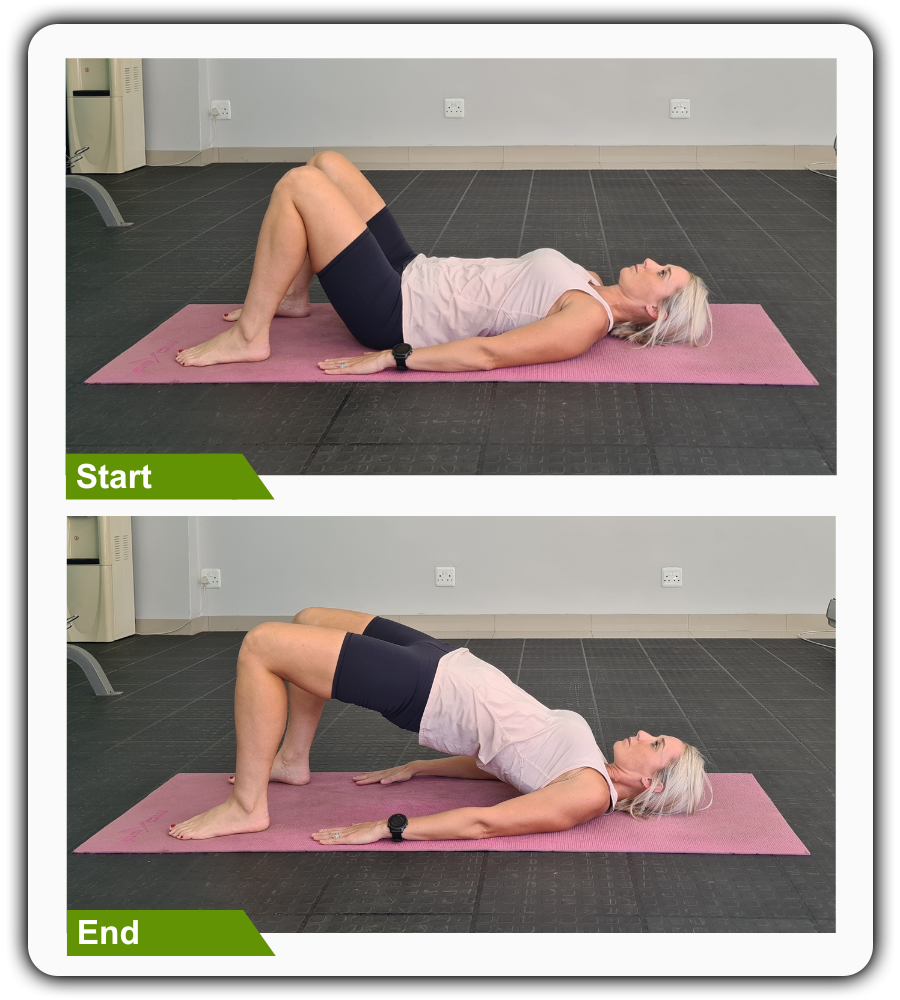
4. Straight Leg Lifts
For this exercise, use the wall, a post, or the back of your chair for balance and support if needed.
Begin in an upright standing position with your feet hip-width apart, maintaining good alignment with your head, shoulders, hips, and legs. Place one hand on your hip as you hold on to the back of the chair with your opposite hand. Engage your core and lift one leg out to the side, ideally to a 30 to 45-degree angle, while keeping your toes pointing forward. Slowly lower your leg to return to the starting position and repeat the movement. After several repetitions, perform the movement on the opposite side. Complete 3 sets of 10 repetitions on each side.
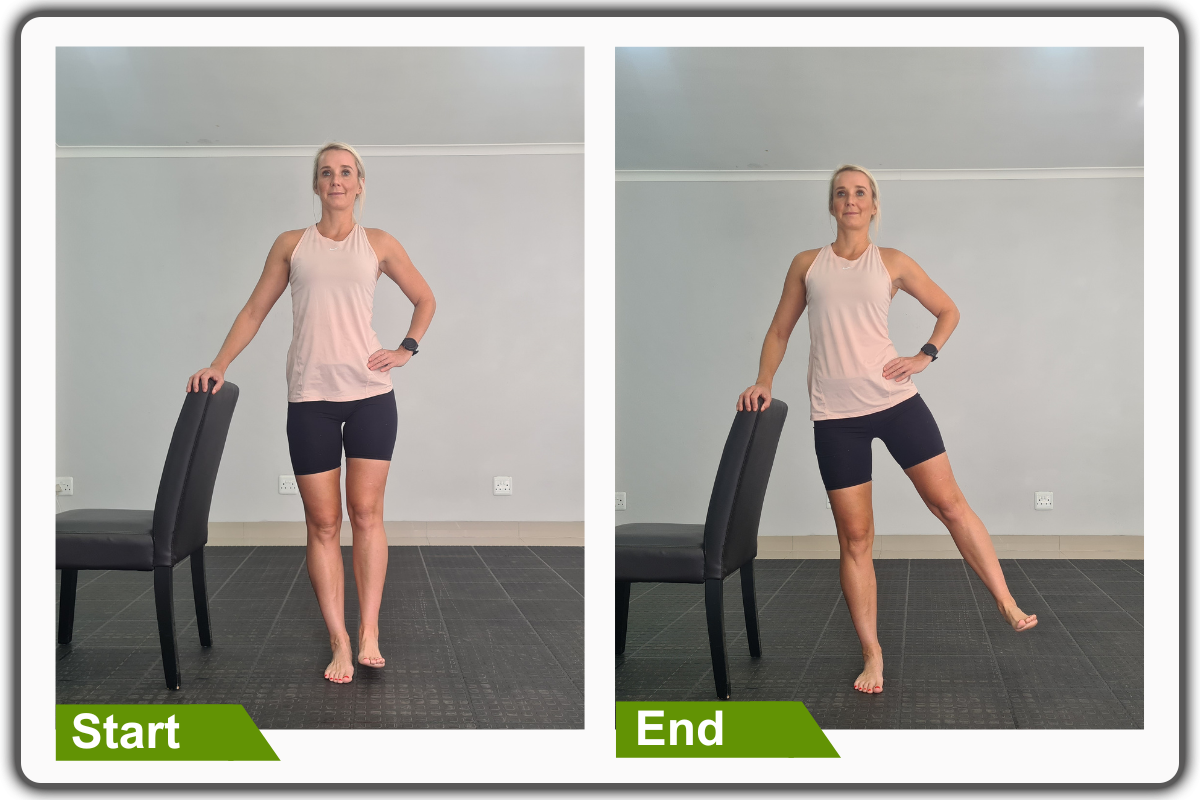
5. Seated Hip Abduction
Begin in an upright sitting position on a chair with your knees bent and feet flat on the floor, maintaining good alignment with your head, shoulders, and hips. Wrap the resistance band around your legs, just above your knees. Engage your core, then bring your legs out to the sides, creating resistance on the band. Hold the position for a couple of seconds. Return to the starting position and repeat the movement. Complete for 10 to 15 repetitions.
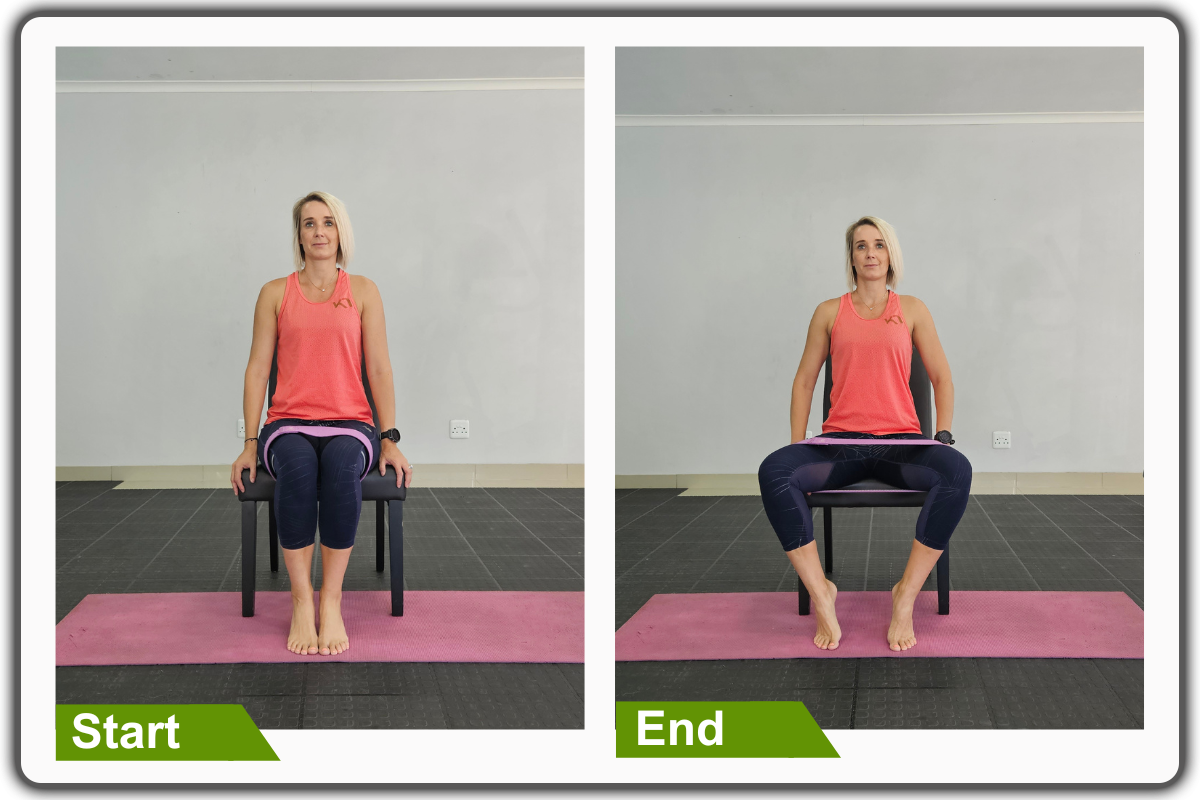
Additional Exercises You Can Do
Seated Bridge
Begin in an upright sitting position on the edge of a chair, maintaining a good alignment with your head, shoulders, and hips. Place your hands at your sides on the chair for support. Engage your core and push from your arms and heels to lift your upper body, bringing your head back. Hold this position for several deep belly breaths, in through your nose and out through your mouth. Relax and return to the starting position.
Seated Clamshell
Begin in an upright sitting position with your knees bent and feet flat on the floor, maintaining proper alignment with your head, shoulders, and hips. Wrap the resistance band around your legs, just above your knees, while keeping your feet together. Tighten your core, then bring your knees out to the sides, creating resistance on the band. Return to the starting position and repeat the movement as needed.
Squat
Begin in an upright standing position in front of a chair with your feet shoulder-width apart, maintaining good alignment with your head, shoulders, hips, and legs. Place one hand on the back of the chair for support and balance if needed. Engage your core. Bend your knees and hinge through your hips to move into a squat position, keeping your knees behind your toes. Raise back up to an upright standing position, squeezing your glutes at the top position. Repeat the movement for 10 repetitions.
Single Leg Bridge
Lie on your back on the floor with your knees bent and your feet flat on the floor, around hip-width apart. Rest your arms at your sides and engage your core. Push from your heels to lift your hips, then extend one leg out to place all of your weight on one foot. Hold this position for a few seconds. Lower your hips back down to return to the starting position. Repeat the movement on the opposite leg. Complete the movement for 2-3 repetitions on each side.
Sumo Squat
Begin in an upright standing position with your feet wider than shoulder-width apart, maintaining a good alignment with your head, shoulders, and hips. Clasp your hands in front of your body and tighten your abdominal muscles. Bend your knees and hinge through your hips to lower your seat into a deep squat position, pressing your elbows between your knees. Sit as deeply as you are able, while evenly distributing your weight across both heels. Hold this position for a couple of seconds. Relax and return to the starting position. Repeat the movement for 12 repetitions.
Tips For Performing Pilates Leg Exercises Safely
Safely performing a Pilates workout goes hand in hand to prevent injury and maximize the effectiveness of your workout.
Here are some tips to help you maintain proper form and technique:
Conclusion
In conclusion, Pilates leg exercises offer a gateway to physical strength and endurance and a deeper connection between mind, body, and spirit. As we've explored, these exercises are integral to the Pilates method, targeting major muscle groups such as the abs, hips, and the top of the left or right leg. All while emphasizing core engagement, precision, and concentration. Through a holistic approach to fitness, these movements enhance strength, flexibility, and stability and promote better posture, alignment, and overall well-being.
By incorporating the principles of Pilates into our leg workouts and following the tips for safe and effective performance, we can embark on a journey toward sculpted limbs and enhanced vitality. Whether young or old, a beginner or an experienced practitioner, Pilates leg exercises offer a versatile and accessible way to strengthen and tone the lower body while fostering a deeper sense of self-awareness and balance.
